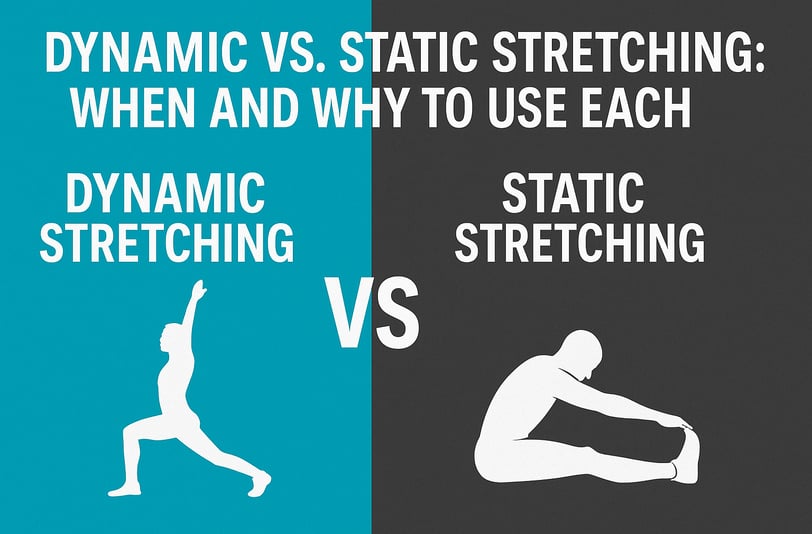Dynamic vs Static Stretching: When & Why It Matters
Discover the key differences between dynamic and static stretching. Learn when to use each for better performance, recovery, and injury prevention.
6/6/20254 min read


Dynamic vs. Static Stretching: When and Why to Use Each
Stretching isn’t just something you tack onto the beginning or end of a workout—it’s a vital part of injury prevention, performance enhancement, and long-term mobility. But not all stretching is created equal. The two most common types, dynamic and static stretching, each have specific purposes and optimal timing.
Let’s break down the science behind both, when to use them, and how to make each one work for your goals—plus a few key tools to maximize the benefits.
What Is Dynamic Stretching?
Dynamic stretching involves movement-based stretches that take muscles and joints through their full range of motion. Think walking lunges, leg swings, or torso twists. These aren’t long holds—you’re actively moving the whole time, which gets the body warmed up and ready to go.
It increases blood flow, activates the nervous system, and improves coordination. A 2013 study in the Journal of Strength and Conditioning Research found that dynamic stretching improved performance in sprint and jump tests compared to static stretching before workouts.
For safer floor-based stretches like world’s greatest stretch or dynamic frog pose, a thick mat like the Gaiam Essentials Premium Yoga Mat offers grip and support, especially if you're stretching on hard gym floors.
What Is Static Stretching?
Static stretching, on the other hand, is all about stillness and control. You ease into a stretch and hold it for 15 to 60 seconds without movement. These stretches help lengthen muscle fibers, improve joint flexibility, and promote muscle relaxation.
Unlike dynamic stretches, static holds are most effective after a workout when muscles are warm. A review in the Scandinavian Journal of Medicine & Science in Sports confirmed that post-exercise static stretching can help improve long-term flexibility and possibly reduce post-workout tightness.
When to Use Each Type (And Why It Matters)
Timing matters more than most people realize. Using the right type of stretch at the wrong time can actually hinder your performance or limit your gains.
Use Dynamic Stretching Before a Workout
You want to activate muscles, not relax them, before training. Dynamic stretches help increase your heart rate, improve blood flow to the muscles, and get the joints moving. That’s why elite athletes use dynamic stretching as part of their warm-up routines.
This kind of movement-based prep is even more effective when preceded by foam rolling. If you’re tight or sore, the BLACKROLL Standard Foam Roller is a great way to reduce muscle restriction and improve range of motion before those dynamic drills.
Use Static Stretching After a Workout
After you train, the goal is the opposite: wind down. Static stretching is ideal for bringing your nervous system into a recovery state. It can help relieve tightness and reduce stiffness, especially after strength training or intense cardio.Aim for 2–3 rounds of static holds per muscle group, especially in areas that feel restricted. Stretching after lifting can also promote better muscle alignment and long-term mobility.
Tools to Deepen Your Stretch
You don’t need to be ultra-flexible to start getting more out of your stretching. A few simple tools can make static stretching safer and more effective—especially if you’re dealing with tight hamstrings or shoulders.
A looped strap like the Trideer Non-Elastic Stretching Strap can help you reach further in poses like seated forward fold or supine hamstring stretch without risking strain or bad form.
Which Type Is Better for Injury Prevention?
Short answer? Both—if used at the right time.
Dynamic stretching primes your joints and muscles to move explosively, reducing the chance of strains or poor mechanics during your workout. Static stretching, while not a magic bullet for injury prevention, helps restore balance and recover mobility over time—both of which lower your injury risk long term.
The most effective injury-prevention strategy includes consistent mobility work, strength training, and post-session recovery practices.
Precision Work: Target Tight Spots
For the really stubborn knots—like deep glute tension, scapular stiffness, or plantar fascia tightness—you may need to go beyond general stretching. That’s where massage tools come in.The Epitomie Fitness Muscle Max Massage Ball is excellent for precision myofascial release. Use it against a wall or on the floor to dig into problem areas that static stretches can’t fully address.
How to Program Both into Your Week
To get the most out of both stretch types, here’s a weekly outline you can follow:
Before every workout: 5–8 minutes of dynamic stretching
After every workout: 5–10 minutes of static holds
1–2 days a week: dedicated flexibility/mobility sessions with a focus on deep static stretches
This combo keeps you moving efficiently and recovering fully without sacrificing performance or risking overuse injuries.
Add Resistance for Progression
Static stretching isn’t always passive. You can make it more active by integrating low-resistance tools that challenge stabilizer muscles and add tension. This helps train control, especially in deeper ranges.
The Synergee Mini Resistance Bands are perfect for this. You can loop them above the knees during a seated butterfly stretch to engage the glutes, or use them in a doorway pec stretch to add external tension on the shoulder girdle.
Final Take: Stretch Smarter, Not Harder
Both dynamic and static stretching have a place in your routine—but they’re not interchangeable. Use dynamic stretches to activate, energize, and prepare. Use static stretches to unwind, lengthen, and restore.If you apply the right method at the right time, you’ll move better, train harder, and recover faster.
Sources:
Cleveland Clinic – Dynamic vs Static Stretching
BMC Musculoskeletal Disorders – Warm-Up Protocol Effects
FITNESS
Nutrition
WellnesS
info@movebetterco.com
© 2025. All rights reserved | Privacy Policy | Terms & Conditions